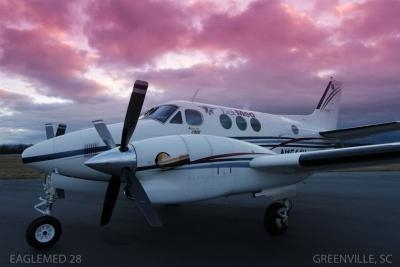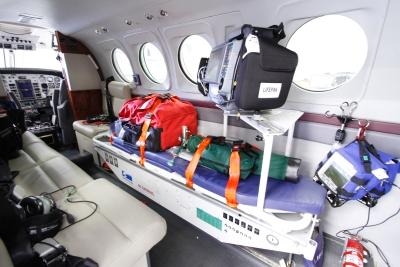Service Employs Pressurized King Air With 900 Mile Range
Greenville Downtown Airport is the new home of a base for
EagleMed, an air ambulance service with bases in Arkansas,
Colorado, Kansas, Missouri, Nebraska, Oklahoma, Texas, New
Mexico.

"From our new base at GMU, we can respond to emergencies within
a 900 mile radius, so from this location we can provide critical
care air transport services as far North as Massachusetts, South
all the way to the tip of Florida, East to the coast and West to
Arkansas, Missouri and Louisiana," said David Ellis, Program
Manager, of EagleMed South Carolina.
When a medical emergency occurs, time is crucial to saving
lives. "Up until now, people in the Upstate of South Carolina who
needed emergency long distance critical care air ambulance service
had to wait for a plane out of Charlotte, NC, or Gwinnett, GA,"
said Ellis. "Often these planes were already booked and some aren't
available 24 hours a day, so during a time sensitive situation,
critical hours were lost," he said.
Ellis said sometimes helicopters are the preferred mode of air
ambulance transportation, because they can land at an accident
scene and take a patient directly to a hospital, therefore
by-passing the need for an airport. But helicopters aren't an
option for long distance trips, because of their slower speed and
their fuel reserve limitations which limits the distance they can
travel without stopping to refuel. Helicopters also can't fly in
some weather conditions, like during times of high winds. Airplanes
can transport larger patients than a helicopter. "Our sister
company, Med-Trans, operates the medical helicopter services for
the Greenville Hospital System, Spartanburg Regional, and AnMed
Hospital in Anderson," stated Ellis. "Through them, we saw the need
for a regional, medically equipped airplane to help patients,"
Ellis said.

"About 50 percent of our flights so far have been to take
patients with serious burns to the regional burn treatment center
in Augusta, GA," Ellis said. "EagleMed will also be used to fly
patients who have suffered a stroke; or are in need of highly
specialized cardiovascular or vascular surgery to Charleston,
S.C.," stated Ellis. "Special pediatric and neonatal patients will
be transported to the Greenville Hospital System or to Charleston,
depending on the situation and their location," Ellis added. "We
are notified of critical care situations by emergency workers, and
while the patient is being stabilized, an ambulance will transport
our specialized team to pick up the patient and bring them to the
airport," Ellis said.
The patient, along with one family member, can then be flown in
the pressurized cabin of a medically equipped King Air 90 aircraft
that has a non-stop range of 900 miles and can fly 250 miles per
hour (mph). All EagleMed aircraft are completely configured for
mission critical transports. Each is equipped with state of the art
medical and emergency equipment like heart monitors that have the
capabilities for monitoring standard heart tracings as well as
12-Lead diagnosing, biphasic defibrillation, pacing, ETCO2, and
pulse oximetry. Other transport equipment includes: transport
ventilators, 3 channel infusion pumps and a medical loading system.
This equipment, in conjunction with the highly skilled medical team
and pilot transform EagleMed's planes into a "flying intensive care
unit".
In comparison, a typical medical helicopter can fly 138 mph,
provides a non-stop range of just 350 miles, the cabin is
non-pressurized and there sometimes isn't room for an accompanying
family member.
"EagleMed reacts to an emergency like an ambulance does, so in
emergent cases we take care of the patient first and figure out the
payment for our services later," stated Ellis "Most air ambulance
services require proof of payment first," according to Ellis. "That
is one reason I am proud to be with EagleMed, the patent's health
comes first, even if we never get paid,' Ellis added.
 Aero-News: Quote of the Day (04.17.24)
Aero-News: Quote of the Day (04.17.24) ANN's Daily Aero-Linx (04.17.24)
ANN's Daily Aero-Linx (04.17.24) Airborne-Flight Training 04.17.24: Feds Need Controllers, Spirit Delay, Redbird
Airborne-Flight Training 04.17.24: Feds Need Controllers, Spirit Delay, Redbird Airborne 04.16.24: RV Update, Affordable Flying Expo, Diamond Lil
Airborne 04.16.24: RV Update, Affordable Flying Expo, Diamond Lil Airborne 04.11.24: SnF24!, King's 50th, Top Rudder, Aileronics
Airborne 04.11.24: SnF24!, King's 50th, Top Rudder, Aileronics




